Leadership and Clinical Governance: Impact of Effective Communication on Patient Safety
VerifiedAdded on 2023/06/15
|10
|2425
|406
AI Summary
This assignment examines the impact of effective communication on maintaining patient safety. It presents a critical analysis of the evidence related to the topic and a reflection on an incident where patient safety was identified at risk as a result of ineffective communication. The discussion is based on the role of the registered nurse as the leader in risk management.
Contribute Materials
Your contribution can guide someone’s learning journey. Share your
documents today.
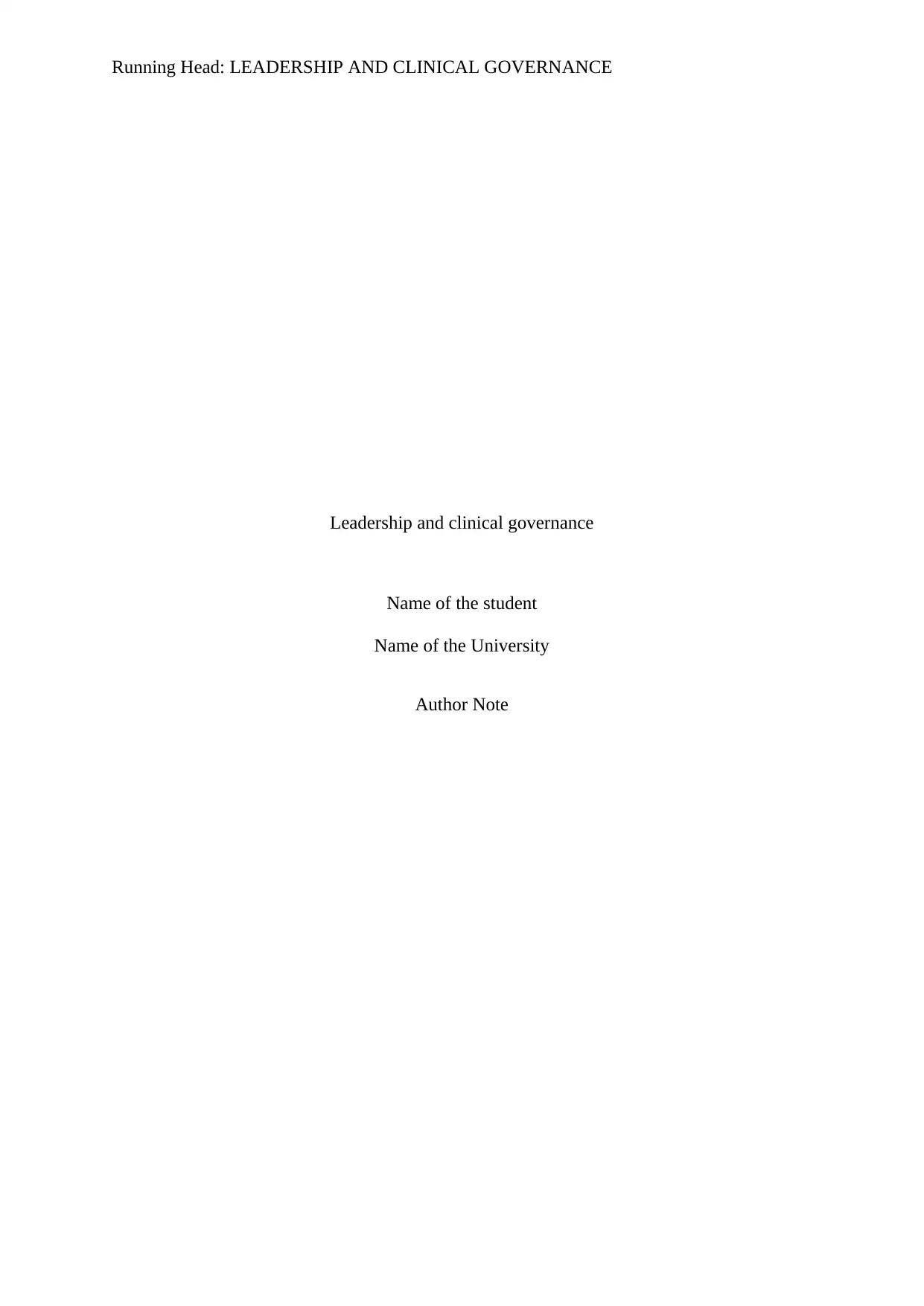
Running Head: LEADERSHIP AND CLINICAL GOVERNANCE
Leadership and clinical governance
Name of the student
Name of the University
Author Note
Leadership and clinical governance
Name of the student
Name of the University
Author Note
Secure Best Marks with AI Grader
Need help grading? Try our AI Grader for instant feedback on your assignments.

1LEADERSHIP AND CLINICAL GOVERNANCE
Introduction
The assignment is the part of learning leadership and clinical governance. A critical
role is played by the nurses in identifying and responding to changes in the health status of
the patient. It is the role of the registered nurse to prevent adverse events and support the
patients throughout the care. A variety of leadership skills are required to be cultivated to
ensure patient safety. One of these skills is to identify and mange the patient risk to safety.
The aim of the assignment is to examine and critically disuses the evidence related to the
impact of effective communication on maintaining patient safety. Further, the assignment
presents the reflection on an incident where the patient safety was identified at risk as a result
of ineffective communication. The discussion in the reflection is based on the role of the
registered nurse as the leader in risk management.
Critical analysis
Patient safety is considered a public health issue. Communication is considered a
crucial factor in the patient care process. According to Brock et al. (2013), communication
between the physicians, patients, nurses, and other care providers is vital for care process.
Adverse events were recorded in the last decade as a result of the miscommunication between
the heath care professionals. Medical errors have been reported in several countries such as
Australia, US and others that were severe and fatal. It was estimated by the World Health
Organisation or WHO that 10% of all the hospital admitted people suffer damage due to care
process (Wittich et al., 2014). Amongst all the adverse events one third of them are found to
result from the human errors. As per the literature review these errors are preventable and can
be prevented by effective communication. It can be interpreted that effective communication
enhances the patient care and it plays a vital role.
Introduction
The assignment is the part of learning leadership and clinical governance. A critical
role is played by the nurses in identifying and responding to changes in the health status of
the patient. It is the role of the registered nurse to prevent adverse events and support the
patients throughout the care. A variety of leadership skills are required to be cultivated to
ensure patient safety. One of these skills is to identify and mange the patient risk to safety.
The aim of the assignment is to examine and critically disuses the evidence related to the
impact of effective communication on maintaining patient safety. Further, the assignment
presents the reflection on an incident where the patient safety was identified at risk as a result
of ineffective communication. The discussion in the reflection is based on the role of the
registered nurse as the leader in risk management.
Critical analysis
Patient safety is considered a public health issue. Communication is considered a
crucial factor in the patient care process. According to Brock et al. (2013), communication
between the physicians, patients, nurses, and other care providers is vital for care process.
Adverse events were recorded in the last decade as a result of the miscommunication between
the heath care professionals. Medical errors have been reported in several countries such as
Australia, US and others that were severe and fatal. It was estimated by the World Health
Organisation or WHO that 10% of all the hospital admitted people suffer damage due to care
process (Wittich et al., 2014). Amongst all the adverse events one third of them are found to
result from the human errors. As per the literature review these errors are preventable and can
be prevented by effective communication. It can be interpreted that effective communication
enhances the patient care and it plays a vital role.

2LEADERSHIP AND CLINICAL GOVERNANCE
In the book, “critical conversation for patient safety: an essential guide for health
professionals” edited by Tracy Levett-Jones, a greater emphasis has been laid on therapeutic
communication. There is a need of therapeutic communication between patients and the
health professionals. However, the focus is now extended to include communication between
the health care providers. The author of the book also emphasise on addressing the critical
relationship between the patent safety and communication. Patient safety is enhanced by the
critical conversation as it bridges the gap between the care providers and the care users
(Levett-Jones, 2017). It means that effective communication is critical not only between the
health care professionals and the patients but also among the health care professionals. It
ensures better sharing of the health status of the patient with other specialists and physicians
in the interdisciplinary team. According to Levett-Jones & Bourgeois (2015), therapeutic and
the interpersonal communication was found to satisfy the innate needs of the patients. It
includes the feelings of safety and confidence during the treatment as outlined in the
Maslow’s hierarchy of needs. There are many evidences that effective communication
ensures the patient safety.
The SBAR system was developed for eliminating the simple communication error in
the health care. This system stands for situation, background, assessment and
recommendations. It is the information transfer system between the nurse and doctor in
concise manner. This tool is used during the medical handover in the intensive care unit. This
system was found to improve the communication between the health care providers and
enhanced the patient safety. However, the tool is criticised in terms of lack of awareness
among the patient and difficulty for nurses in communicating the sensitive issues to the
patient (Randmaa et al., 2014). It can be interpreted from the literature review that there are
more advantages than disadvantages of SBAR in ensuring the patient safety. It can be
In the book, “critical conversation for patient safety: an essential guide for health
professionals” edited by Tracy Levett-Jones, a greater emphasis has been laid on therapeutic
communication. There is a need of therapeutic communication between patients and the
health professionals. However, the focus is now extended to include communication between
the health care providers. The author of the book also emphasise on addressing the critical
relationship between the patent safety and communication. Patient safety is enhanced by the
critical conversation as it bridges the gap between the care providers and the care users
(Levett-Jones, 2017). It means that effective communication is critical not only between the
health care professionals and the patients but also among the health care professionals. It
ensures better sharing of the health status of the patient with other specialists and physicians
in the interdisciplinary team. According to Levett-Jones & Bourgeois (2015), therapeutic and
the interpersonal communication was found to satisfy the innate needs of the patients. It
includes the feelings of safety and confidence during the treatment as outlined in the
Maslow’s hierarchy of needs. There are many evidences that effective communication
ensures the patient safety.
The SBAR system was developed for eliminating the simple communication error in
the health care. This system stands for situation, background, assessment and
recommendations. It is the information transfer system between the nurse and doctor in
concise manner. This tool is used during the medical handover in the intensive care unit. This
system was found to improve the communication between the health care providers and
enhanced the patient safety. However, the tool is criticised in terms of lack of awareness
among the patient and difficulty for nurses in communicating the sensitive issues to the
patient (Randmaa et al., 2014). It can be interpreted from the literature review that there are
more advantages than disadvantages of SBAR in ensuring the patient safety. It can be
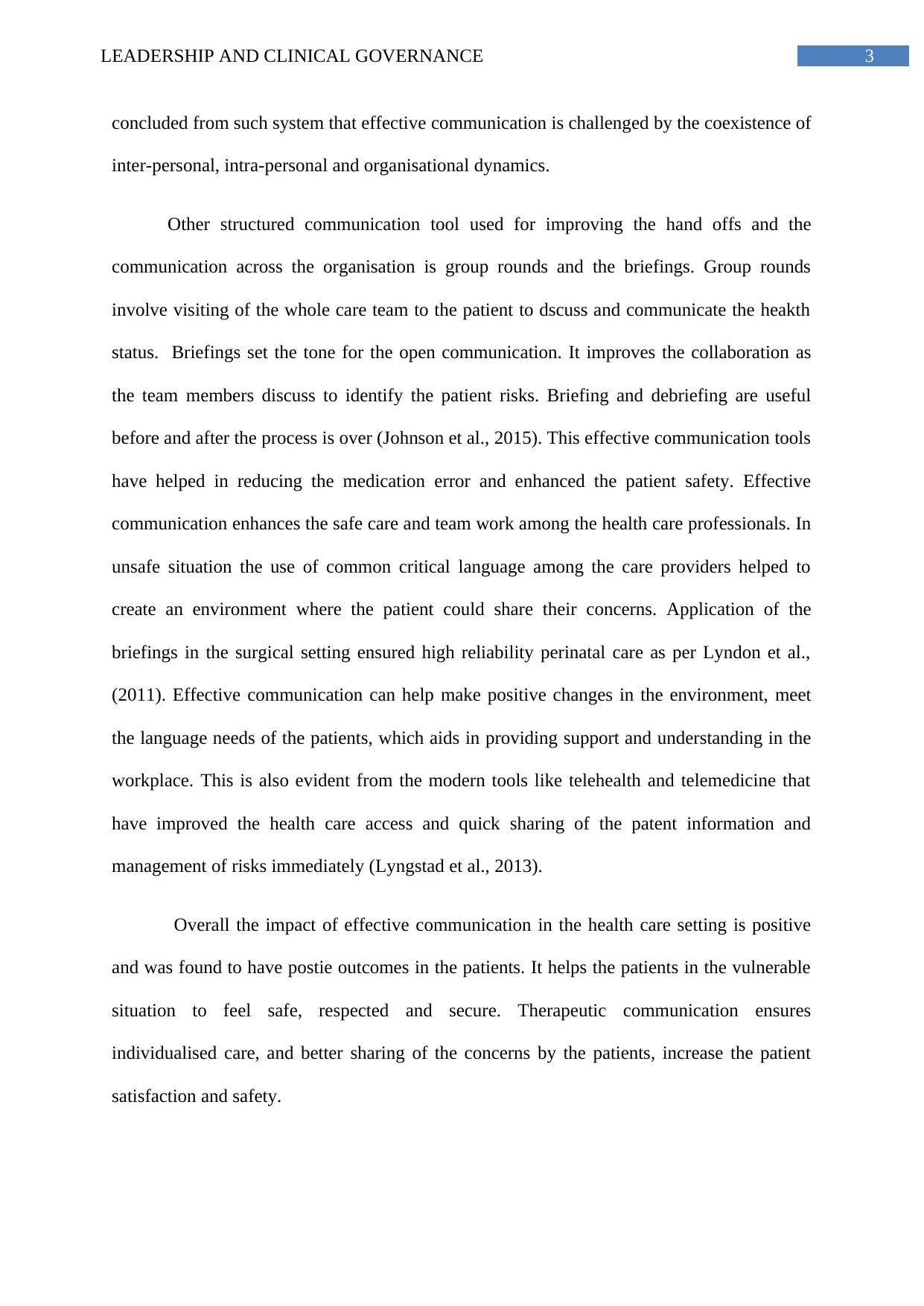
3LEADERSHIP AND CLINICAL GOVERNANCE
concluded from such system that effective communication is challenged by the coexistence of
inter-personal, intra-personal and organisational dynamics.
Other structured communication tool used for improving the hand offs and the
communication across the organisation is group rounds and the briefings. Group rounds
involve visiting of the whole care team to the patient to dscuss and communicate the heakth
status. Briefings set the tone for the open communication. It improves the collaboration as
the team members discuss to identify the patient risks. Briefing and debriefing are useful
before and after the process is over (Johnson et al., 2015). This effective communication tools
have helped in reducing the medication error and enhanced the patient safety. Effective
communication enhances the safe care and team work among the health care professionals. In
unsafe situation the use of common critical language among the care providers helped to
create an environment where the patient could share their concerns. Application of the
briefings in the surgical setting ensured high reliability perinatal care as per Lyndon et al.,
(2011). Effective communication can help make positive changes in the environment, meet
the language needs of the patients, which aids in providing support and understanding in the
workplace. This is also evident from the modern tools like telehealth and telemedicine that
have improved the health care access and quick sharing of the patent information and
management of risks immediately (Lyngstad et al., 2013).
Overall the impact of effective communication in the health care setting is positive
and was found to have postie outcomes in the patients. It helps the patients in the vulnerable
situation to feel safe, respected and secure. Therapeutic communication ensures
individualised care, and better sharing of the concerns by the patients, increase the patient
satisfaction and safety.
concluded from such system that effective communication is challenged by the coexistence of
inter-personal, intra-personal and organisational dynamics.
Other structured communication tool used for improving the hand offs and the
communication across the organisation is group rounds and the briefings. Group rounds
involve visiting of the whole care team to the patient to dscuss and communicate the heakth
status. Briefings set the tone for the open communication. It improves the collaboration as
the team members discuss to identify the patient risks. Briefing and debriefing are useful
before and after the process is over (Johnson et al., 2015). This effective communication tools
have helped in reducing the medication error and enhanced the patient safety. Effective
communication enhances the safe care and team work among the health care professionals. In
unsafe situation the use of common critical language among the care providers helped to
create an environment where the patient could share their concerns. Application of the
briefings in the surgical setting ensured high reliability perinatal care as per Lyndon et al.,
(2011). Effective communication can help make positive changes in the environment, meet
the language needs of the patients, which aids in providing support and understanding in the
workplace. This is also evident from the modern tools like telehealth and telemedicine that
have improved the health care access and quick sharing of the patent information and
management of risks immediately (Lyngstad et al., 2013).
Overall the impact of effective communication in the health care setting is positive
and was found to have postie outcomes in the patients. It helps the patients in the vulnerable
situation to feel safe, respected and secure. Therapeutic communication ensures
individualised care, and better sharing of the concerns by the patients, increase the patient
satisfaction and safety.
Secure Best Marks with AI Grader
Need help grading? Try our AI Grader for instant feedback on your assignments.

4LEADERSHIP AND CLINICAL GOVERNANCE
Reflection
Refection is the process of learning from mistakes and makes better decisions. In
health care system reflection helps in healing and therapeutic process (Tashiroe et al., 2013).
I was placed in the mental health setting where I have diagnosed him with Schizophrenia.
While I was conducting the mini mental settle exam I realised that he was answering
irrelevantly. The other nurse in the room rebuked him for his behaviour which made the
patient more aggressive. I realised that the patient was at risk of physical harm due to lack of
empathy and emotional abuse by other nose in the wards. The patient needed effective verbal
and nonverbal communication as the ineffective communication has shattered the nurse
patient relationship. I could observe a gap formed and the patient concerns were not
addressed.
I was determined to adhere to the Nursing and Midwifery Board of Australia’s
nursing standards of registered nurse. I approached to the patient once again and continued
with my examination. I engaged with him in therapeutic relationship. I was critically
analysing his symptoms with the evidence based information
(Nursingmidwiferyboard.gov.au., 2017). The patient shared that he does not feel like living. I
was aware of the accountability of my practice. I also responded to the other nurse’s
capability for practice to prevent harm to any other patient by emotional abuse. I ensured
conducting the assessment of the patient with holistic and culturally appropriate approach. I
planned for actions that were ethical and goal directed and evaluated the outcomes on a
timely basis (Nursingmidwiferyboard.gov.au, 2017).
As a part of my leadership imitative I conveyed the other nurse about her poor nursing
management, communication error and insufficient training evident from such behaviour. My
aim was to increase the supervision to prevent such ineffective communication by carers.
According to Laschinger (2014) lack of supervision and workplace mistreatment is the barrier
Reflection
Refection is the process of learning from mistakes and makes better decisions. In
health care system reflection helps in healing and therapeutic process (Tashiroe et al., 2013).
I was placed in the mental health setting where I have diagnosed him with Schizophrenia.
While I was conducting the mini mental settle exam I realised that he was answering
irrelevantly. The other nurse in the room rebuked him for his behaviour which made the
patient more aggressive. I realised that the patient was at risk of physical harm due to lack of
empathy and emotional abuse by other nose in the wards. The patient needed effective verbal
and nonverbal communication as the ineffective communication has shattered the nurse
patient relationship. I could observe a gap formed and the patient concerns were not
addressed.
I was determined to adhere to the Nursing and Midwifery Board of Australia’s
nursing standards of registered nurse. I approached to the patient once again and continued
with my examination. I engaged with him in therapeutic relationship. I was critically
analysing his symptoms with the evidence based information
(Nursingmidwiferyboard.gov.au., 2017). The patient shared that he does not feel like living. I
was aware of the accountability of my practice. I also responded to the other nurse’s
capability for practice to prevent harm to any other patient by emotional abuse. I ensured
conducting the assessment of the patient with holistic and culturally appropriate approach. I
planned for actions that were ethical and goal directed and evaluated the outcomes on a
timely basis (Nursingmidwiferyboard.gov.au, 2017).
As a part of my leadership imitative I conveyed the other nurse about her poor nursing
management, communication error and insufficient training evident from such behaviour. My
aim was to increase the supervision to prevent such ineffective communication by carers.
According to Laschinger (2014) lack of supervision and workplace mistreatment is the barrier
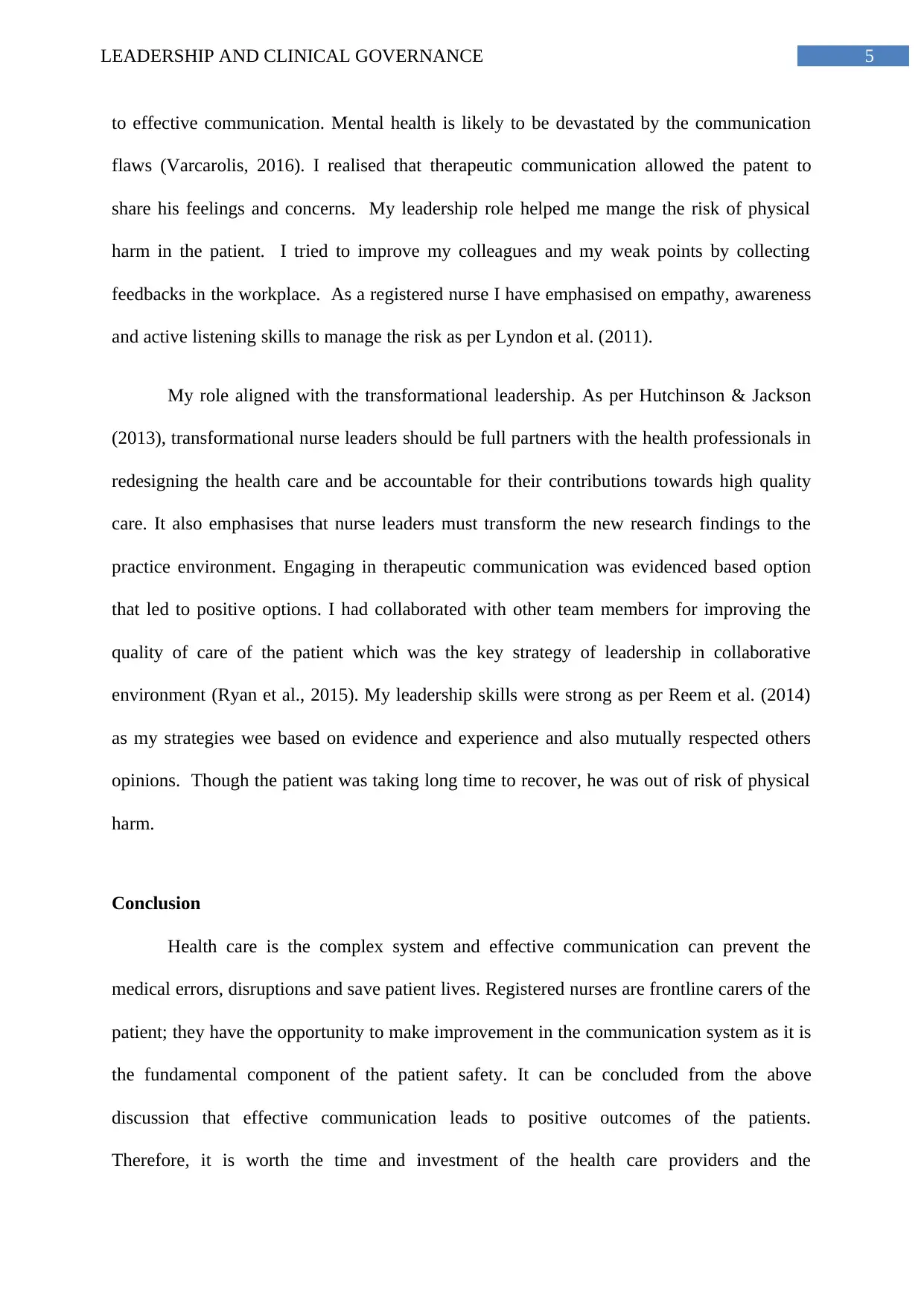
5LEADERSHIP AND CLINICAL GOVERNANCE
to effective communication. Mental health is likely to be devastated by the communication
flaws (Varcarolis, 2016). I realised that therapeutic communication allowed the patent to
share his feelings and concerns. My leadership role helped me mange the risk of physical
harm in the patient. I tried to improve my colleagues and my weak points by collecting
feedbacks in the workplace. As a registered nurse I have emphasised on empathy, awareness
and active listening skills to manage the risk as per Lyndon et al. (2011).
My role aligned with the transformational leadership. As per Hutchinson & Jackson
(2013), transformational nurse leaders should be full partners with the health professionals in
redesigning the health care and be accountable for their contributions towards high quality
care. It also emphasises that nurse leaders must transform the new research findings to the
practice environment. Engaging in therapeutic communication was evidenced based option
that led to positive options. I had collaborated with other team members for improving the
quality of care of the patient which was the key strategy of leadership in collaborative
environment (Ryan et al., 2015). My leadership skills were strong as per Reem et al. (2014)
as my strategies wee based on evidence and experience and also mutually respected others
opinions. Though the patient was taking long time to recover, he was out of risk of physical
harm.
Conclusion
Health care is the complex system and effective communication can prevent the
medical errors, disruptions and save patient lives. Registered nurses are frontline carers of the
patient; they have the opportunity to make improvement in the communication system as it is
the fundamental component of the patient safety. It can be concluded from the above
discussion that effective communication leads to positive outcomes of the patients.
Therefore, it is worth the time and investment of the health care providers and the
to effective communication. Mental health is likely to be devastated by the communication
flaws (Varcarolis, 2016). I realised that therapeutic communication allowed the patent to
share his feelings and concerns. My leadership role helped me mange the risk of physical
harm in the patient. I tried to improve my colleagues and my weak points by collecting
feedbacks in the workplace. As a registered nurse I have emphasised on empathy, awareness
and active listening skills to manage the risk as per Lyndon et al. (2011).
My role aligned with the transformational leadership. As per Hutchinson & Jackson
(2013), transformational nurse leaders should be full partners with the health professionals in
redesigning the health care and be accountable for their contributions towards high quality
care. It also emphasises that nurse leaders must transform the new research findings to the
practice environment. Engaging in therapeutic communication was evidenced based option
that led to positive options. I had collaborated with other team members for improving the
quality of care of the patient which was the key strategy of leadership in collaborative
environment (Ryan et al., 2015). My leadership skills were strong as per Reem et al. (2014)
as my strategies wee based on evidence and experience and also mutually respected others
opinions. Though the patient was taking long time to recover, he was out of risk of physical
harm.
Conclusion
Health care is the complex system and effective communication can prevent the
medical errors, disruptions and save patient lives. Registered nurses are frontline carers of the
patient; they have the opportunity to make improvement in the communication system as it is
the fundamental component of the patient safety. It can be concluded from the above
discussion that effective communication leads to positive outcomes of the patients.
Therefore, it is worth the time and investment of the health care providers and the

6LEADERSHIP AND CLINICAL GOVERNANCE
organisation. Nurse may commit error in communication skills. To sustain the therapeutic
nurse-patient relationship effective communication and leadership skills are required by
registered nurse. Transformational leadership is the effective leadership style in addressing
the communication barrier in health care and enhancing the patient safety.
organisation. Nurse may commit error in communication skills. To sustain the therapeutic
nurse-patient relationship effective communication and leadership skills are required by
registered nurse. Transformational leadership is the effective leadership style in addressing
the communication barrier in health care and enhancing the patient safety.
Paraphrase This Document
Need a fresh take? Get an instant paraphrase of this document with our AI Paraphraser
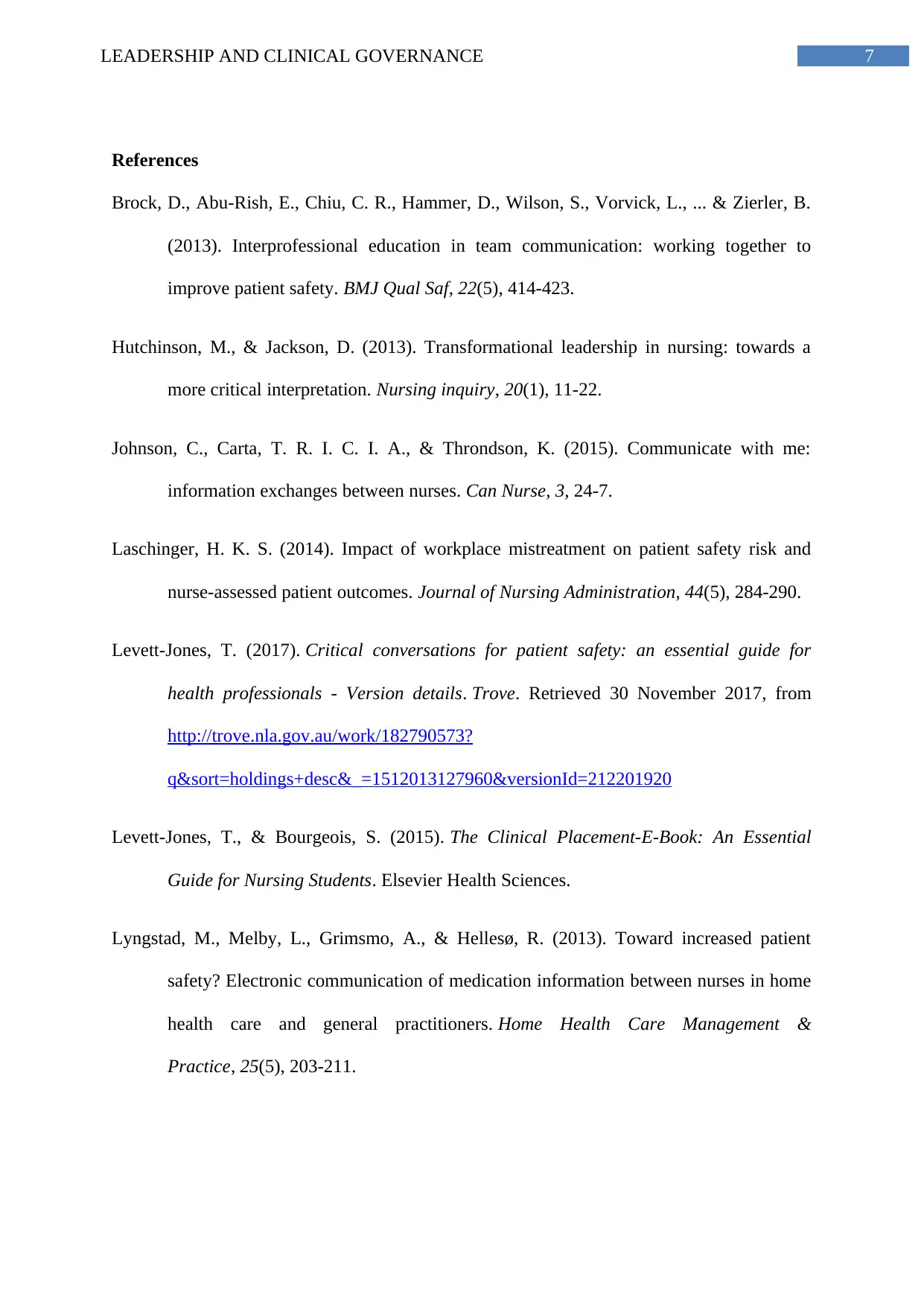
7LEADERSHIP AND CLINICAL GOVERNANCE
References
Brock, D., Abu-Rish, E., Chiu, C. R., Hammer, D., Wilson, S., Vorvick, L., ... & Zierler, B.
(2013). Interprofessional education in team communication: working together to
improve patient safety. BMJ Qual Saf, 22(5), 414-423.
Hutchinson, M., & Jackson, D. (2013). Transformational leadership in nursing: towards a
more critical interpretation. Nursing inquiry, 20(1), 11-22.
Johnson, C., Carta, T. R. I. C. I. A., & Throndson, K. (2015). Communicate with me:
information exchanges between nurses. Can Nurse, 3, 24-7.
Laschinger, H. K. S. (2014). Impact of workplace mistreatment on patient safety risk and
nurse-assessed patient outcomes. Journal of Nursing Administration, 44(5), 284-290.
Levett-Jones, T. (2017). Critical conversations for patient safety: an essential guide for
health professionals - Version details. Trove. Retrieved 30 November 2017, from
http://trove.nla.gov.au/work/182790573?
q&sort=holdings+desc&_=1512013127960&versionId=212201920
Levett-Jones, T., & Bourgeois, S. (2015). The Clinical Placement-E-Book: An Essential
Guide for Nursing Students. Elsevier Health Sciences.
Lyngstad, M., Melby, L., Grimsmo, A., & Hellesø, R. (2013). Toward increased patient
safety? Electronic communication of medication information between nurses in home
health care and general practitioners. Home Health Care Management &
Practice, 25(5), 203-211.
References
Brock, D., Abu-Rish, E., Chiu, C. R., Hammer, D., Wilson, S., Vorvick, L., ... & Zierler, B.
(2013). Interprofessional education in team communication: working together to
improve patient safety. BMJ Qual Saf, 22(5), 414-423.
Hutchinson, M., & Jackson, D. (2013). Transformational leadership in nursing: towards a
more critical interpretation. Nursing inquiry, 20(1), 11-22.
Johnson, C., Carta, T. R. I. C. I. A., & Throndson, K. (2015). Communicate with me:
information exchanges between nurses. Can Nurse, 3, 24-7.
Laschinger, H. K. S. (2014). Impact of workplace mistreatment on patient safety risk and
nurse-assessed patient outcomes. Journal of Nursing Administration, 44(5), 284-290.
Levett-Jones, T. (2017). Critical conversations for patient safety: an essential guide for
health professionals - Version details. Trove. Retrieved 30 November 2017, from
http://trove.nla.gov.au/work/182790573?
q&sort=holdings+desc&_=1512013127960&versionId=212201920
Levett-Jones, T., & Bourgeois, S. (2015). The Clinical Placement-E-Book: An Essential
Guide for Nursing Students. Elsevier Health Sciences.
Lyngstad, M., Melby, L., Grimsmo, A., & Hellesø, R. (2013). Toward increased patient
safety? Electronic communication of medication information between nurses in home
health care and general practitioners. Home Health Care Management &
Practice, 25(5), 203-211.
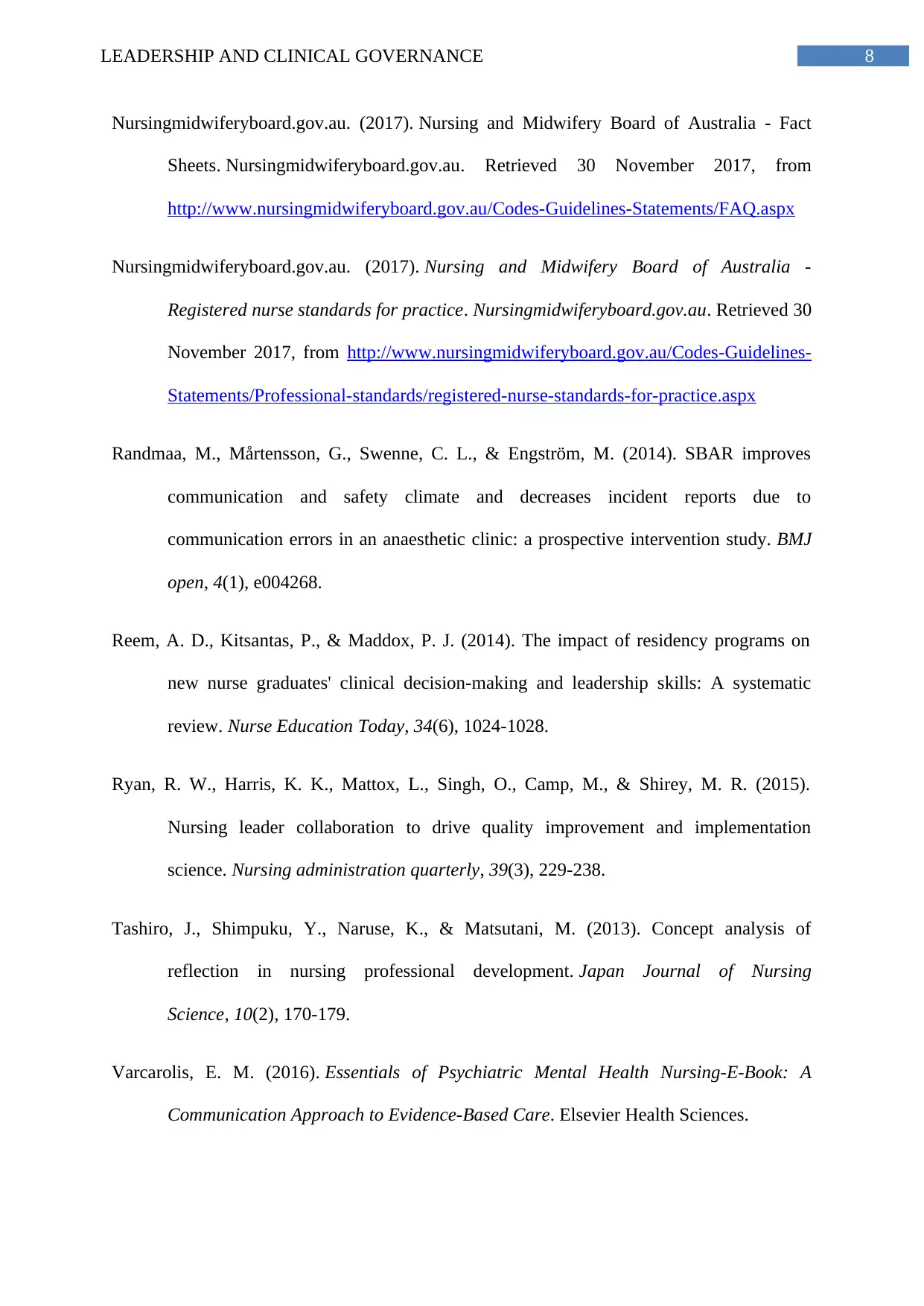
8LEADERSHIP AND CLINICAL GOVERNANCE
Nursingmidwiferyboard.gov.au. (2017). Nursing and Midwifery Board of Australia - Fact
Sheets. Nursingmidwiferyboard.gov.au. Retrieved 30 November 2017, from
http://www.nursingmidwiferyboard.gov.au/Codes-Guidelines-Statements/FAQ.aspx
Nursingmidwiferyboard.gov.au. (2017). Nursing and Midwifery Board of Australia -
Registered nurse standards for practice. Nursingmidwiferyboard.gov.au. Retrieved 30
November 2017, from http://www.nursingmidwiferyboard.gov.au/Codes-Guidelines-
Statements/Professional-standards/registered-nurse-standards-for-practice.aspx
Randmaa, M., Mårtensson, G., Swenne, C. L., & Engström, M. (2014). SBAR improves
communication and safety climate and decreases incident reports due to
communication errors in an anaesthetic clinic: a prospective intervention study. BMJ
open, 4(1), e004268.
Reem, A. D., Kitsantas, P., & Maddox, P. J. (2014). The impact of residency programs on
new nurse graduates' clinical decision-making and leadership skills: A systematic
review. Nurse Education Today, 34(6), 1024-1028.
Ryan, R. W., Harris, K. K., Mattox, L., Singh, O., Camp, M., & Shirey, M. R. (2015).
Nursing leader collaboration to drive quality improvement and implementation
science. Nursing administration quarterly, 39(3), 229-238.
Tashiro, J., Shimpuku, Y., Naruse, K., & Matsutani, M. (2013). Concept analysis of
reflection in nursing professional development. Japan Journal of Nursing
Science, 10(2), 170-179.
Varcarolis, E. M. (2016). Essentials of Psychiatric Mental Health Nursing-E-Book: A
Communication Approach to Evidence-Based Care. Elsevier Health Sciences.
Nursingmidwiferyboard.gov.au. (2017). Nursing and Midwifery Board of Australia - Fact
Sheets. Nursingmidwiferyboard.gov.au. Retrieved 30 November 2017, from
http://www.nursingmidwiferyboard.gov.au/Codes-Guidelines-Statements/FAQ.aspx
Nursingmidwiferyboard.gov.au. (2017). Nursing and Midwifery Board of Australia -
Registered nurse standards for practice. Nursingmidwiferyboard.gov.au. Retrieved 30
November 2017, from http://www.nursingmidwiferyboard.gov.au/Codes-Guidelines-
Statements/Professional-standards/registered-nurse-standards-for-practice.aspx
Randmaa, M., Mårtensson, G., Swenne, C. L., & Engström, M. (2014). SBAR improves
communication and safety climate and decreases incident reports due to
communication errors in an anaesthetic clinic: a prospective intervention study. BMJ
open, 4(1), e004268.
Reem, A. D., Kitsantas, P., & Maddox, P. J. (2014). The impact of residency programs on
new nurse graduates' clinical decision-making and leadership skills: A systematic
review. Nurse Education Today, 34(6), 1024-1028.
Ryan, R. W., Harris, K. K., Mattox, L., Singh, O., Camp, M., & Shirey, M. R. (2015).
Nursing leader collaboration to drive quality improvement and implementation
science. Nursing administration quarterly, 39(3), 229-238.
Tashiro, J., Shimpuku, Y., Naruse, K., & Matsutani, M. (2013). Concept analysis of
reflection in nursing professional development. Japan Journal of Nursing
Science, 10(2), 170-179.
Varcarolis, E. M. (2016). Essentials of Psychiatric Mental Health Nursing-E-Book: A
Communication Approach to Evidence-Based Care. Elsevier Health Sciences.
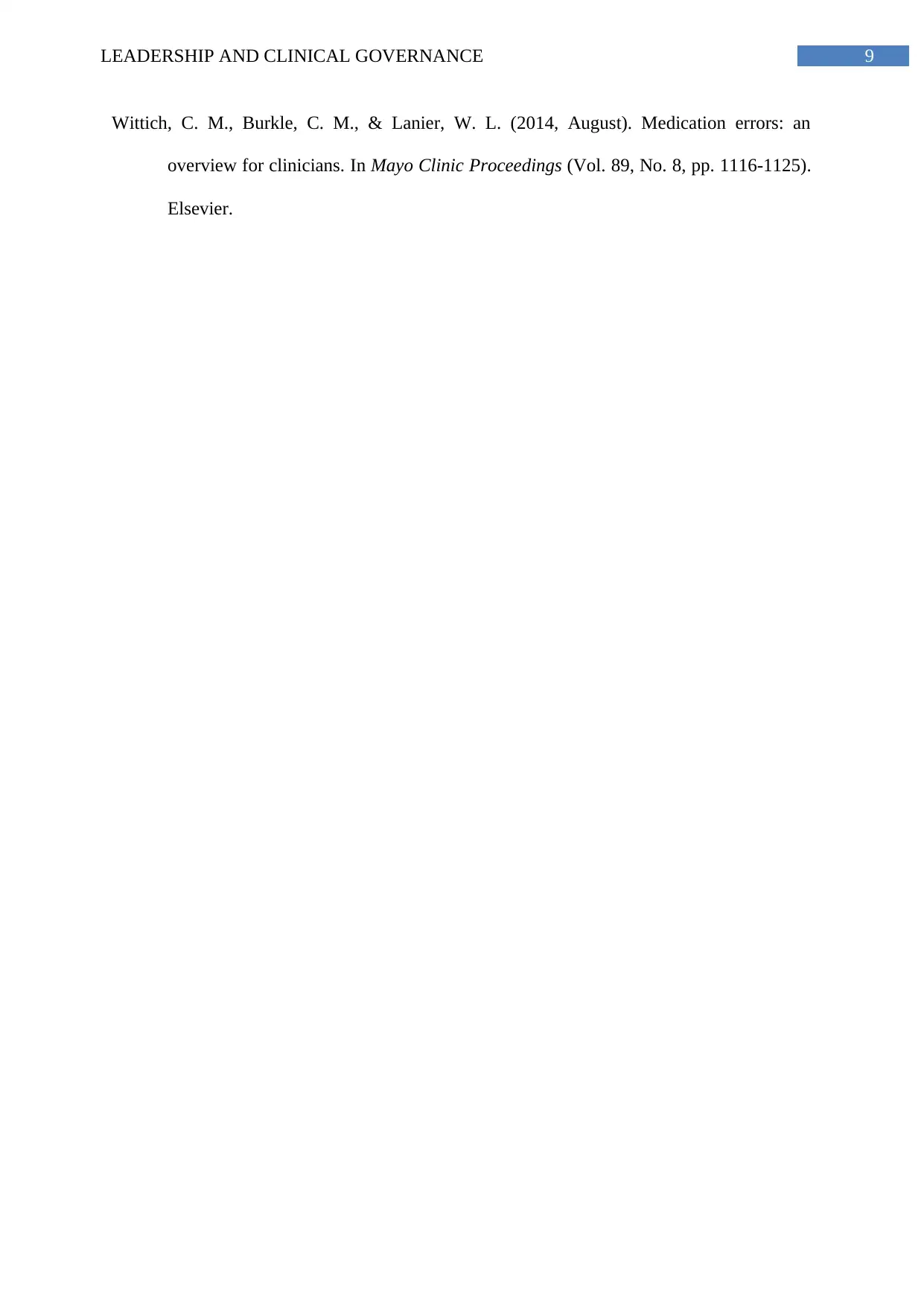
9LEADERSHIP AND CLINICAL GOVERNANCE
Wittich, C. M., Burkle, C. M., & Lanier, W. L. (2014, August). Medication errors: an
overview for clinicians. In Mayo Clinic Proceedings (Vol. 89, No. 8, pp. 1116-1125).
Elsevier.
Wittich, C. M., Burkle, C. M., & Lanier, W. L. (2014, August). Medication errors: an
overview for clinicians. In Mayo Clinic Proceedings (Vol. 89, No. 8, pp. 1116-1125).
Elsevier.
1 out of 10
Related Documents
Your All-in-One AI-Powered Toolkit for Academic Success.
+13062052269
info@desklib.com
Available 24*7 on WhatsApp / Email
![[object Object]](/_next/static/media/star-bottom.7253800d.svg)
Unlock your academic potential
© 2024 | Zucol Services PVT LTD | All rights reserved.





